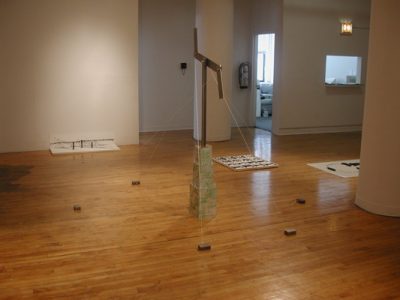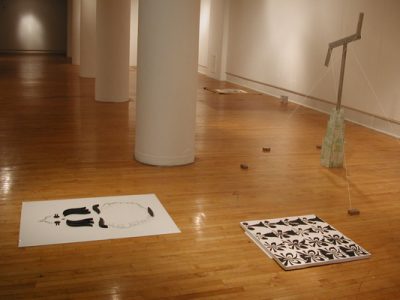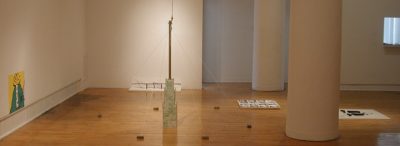Exhibitions
ABOUT THE EXHIBITION
Contemporary art is marked by uncertainty and paradox. By framing Tacita Dean ’s audio work, Lara Lapinski ’s and John Neff ’s sculptures, and Kori Newkirk ’s photography as allegory, Gallery 400 ’s Loop exhibition reveals the perpetually deferred contradictions in viewing and making contemporary art.
If we understand that contemporary art today is marked by uncertainty and paradox, Loop proposes allegory as the interpretive key to understanding the structure and meaning of this ambiguity.
If we understand that contemporary art today is marked by uncertainty and paradox, Loop proposes allegory as the interpretive key to understanding the structure and meaning of this ambiguity. A longstanding tradition in art and literature, allegory in the 1800s at the birth of modernism was relegated to the dark corners of interpretive strategy. Though a few writers in the interim, Charles Baudelaire and Water Benjamin among the most important, maintained the importance of allegory in comprehending aesthetic work, it wasn ’t until the 1980s and the emergence of postmodern theory that allegory was understood as a structure for contemporary work. The legacy of the 1980s may be hard to identify in today ’s artwork, but interpretation through allegory seems much underused.
What an allegorical understanding of works can do is unlock how works embody ideas and how works operate as they reveal themselves. The allegorical artwork and allegorical interpretation understand that there is no fixed, solid, wholly separable meaning to a work, but that meaning is strung together through a chain of associations.
Tacita Dean ’s Trying to Find Spiral Jetty has at its center the pursuit of the mythical Salt Lake artwork of Robert Smithson. Craig Owens, a key 1980s theorist of the allegorical impulse, first wrote of the identifiably allegorical postmodern when he reviewed Smithson ’s collected writings. For Owens, Spiral Jetty embodied the disjunctive and dispersed quality of allegory. The way we know or have seen Spiral Jetty is through multiple media—in photographs, through Smithson ’s writing, in his film, and other accounts of the work. Dean extends this dispersion with audio documentation of a journey she made in 1997 with a friend in order to find Spiral Jetty. Following directions supplied by the Utah Arts Council, Dean and her friend discuss the directions, the landscape around them, and the mistakes they make as they try to find the elusive Jetty. Though the work never makes clear that they have found the Jetty, their spoken accounts of the landscape and text evoke the Jetty in the myriad visual and textual forms through which we have known it. This recollection of visual and textual versions recalls the structural elements of the Jetty, which was designed to be seen and experienced in differentiated ways, physically from the air or on foot, textually and visually in magazines and associated artworks. As Owens and Benjamin before had noted, the allegorical extends the temporal across the spatial. As in history painting, the past, present, and future collide in the work ’s one location. Dean ’s search for the Jetty and the reliability or unreliability of her account allegorize the pursuit of a central element, only to find that it is constituted in fragments.
Lisa Lapinski ’s All of Rimbaud ’s Trades, similarly fragmentary, also evokes a journey and an artistic forbearer, in her case the French Symbolist poet Arthur Rimbaud. After abandoning writing in his late teens, Rimbaud wandered across Europe and settled in North Africa. While there, he gathered books on thirty different trades as varied as candle making, steamboat captaining, and forestry. Lapinski ’s original plan had been to use the methods of Rimbuad ’s trade to create a humorously inspired heterogeneous assemblage sculpture. This proved as difficult for her as learning the many trades did for Rimbaud. In the end, Lapinski ’s depictions of telegraphic transmissions, semaphore flag signaling, and metallurgical charts point to forms of communication and translation inherent in language ’s multiple forms.
Kori Newkrik treats a gesture similarly. An image of two crossed fingers, Void of Silence, might depict a desire for luck or it might signify a willingness to lie and a hope to get away with it. That luck and lying are announced in the same gesture is paradoxical, yet even more so is the fact that Newkirk ’s hand is black and that the gesture evokes past symbols of black power and pride.
Related:
ARTISTS
Tacita Dean, Lisa Lapinski, John Neff, and Kori Newkirk
SUPPORT
Loop is supported by the College of Architecture and the Arts, University of Illinois at Chicago, and a grant from the Illinois Arts Council, a state agency.





